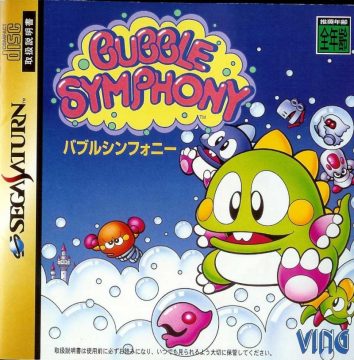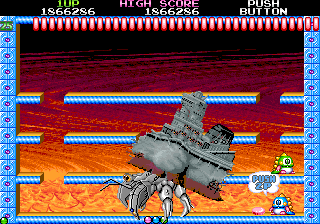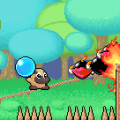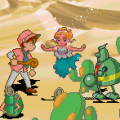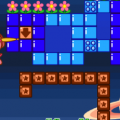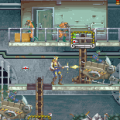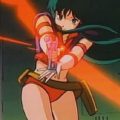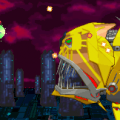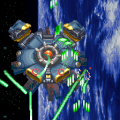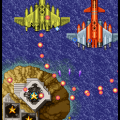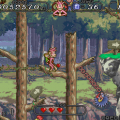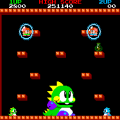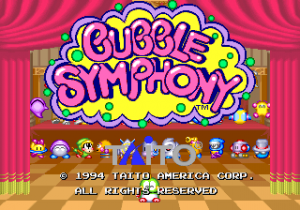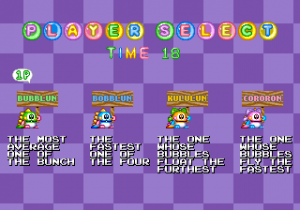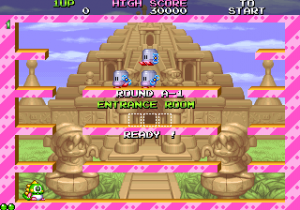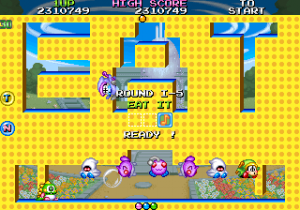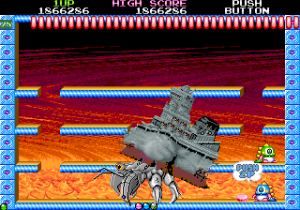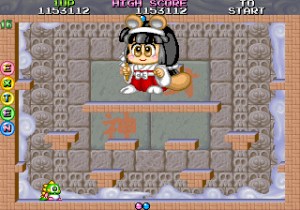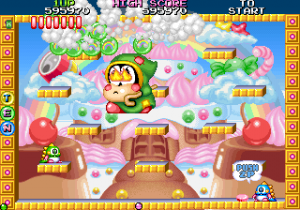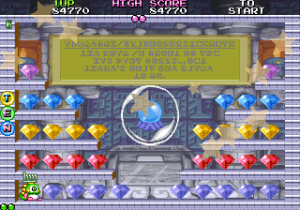The next direct entry in the Bubble Bobble series – Bubble Symphony – hews extremely closely to the original Bubble Bobble. Players still control bubble dragons who trap cutesy enemies in bubbles, pop them, and then collect the resulting bonus items they leave behind. While it would be easy to write Symphony off as a copy of the original, there’s actually a great number of improvements made to the game that results in it being far more accessible than the original.
In Bubble Symphony, the children of Bub and Bob (known as Bubby and Bobby in the intro) take center stage as they accidentally release Hyper Drunk, who immediately swears revenge on their parents and transforms their children into bubble dragons and banishes them to a strange world full of monsters. It’s up to Bubblun, Bobblun, and their sisters Kululun and Cororon to defeat Hyper Drunk and reclaim their human forms.
One of the first major changes made to Bubble Symphony is the addition of four playable characters. While players could originally assume the roles of Bub or Bob in the original, they were little more than palette swaps of each other. In Symphony each character possesses different attributes with Bobblun moving faster than the other characters, Kululun having the highest range but slow speed, Cororon having the fastest shooting speed, and Bubblun being dead center in all attributes and ultimately controlling exactly like Bub and Bob from the original game.
A new charge attack has been added to the game as well. Holding down the fire button for a few seconds causes an aura to appear around the top of the bubble dragons’ heads and, when released, fires a pattern of bubbles unique to each character. Bubblun fires a group of three bubbles ahead of himself, while Bobblun unleashes three in a spread pattern. The sisters Cororon and Kululun fire bubbles in an upside down T shape and rightside up T shape respectively. Though this is an interesting addition, the abilities aren’t particularly useful. The attack takes too long to charge, and the bubbles frequently get caught on the geometry of the stages causing them to pop harmlessly before having a chance to be useful. Worse still, the charged bubbles are nearly useless during boss fights as they don’t take on the properties of the potions needed to damage the boss.
Bubble Symphony is not a straight crawl through a 100-floor cavern like the original. Plays can instead select branching paths through various worlds with different themes and enemies. Many of these worlds and enemies reference other Taito properties like Kiki KaiKai – known as Pocky and Rocky in North America – and Darius. This helps to keep the game fresh, rather than facing the same levels over and over again.
As players work their way through each world they are now charged with finding music note cards that are critical in reaching the final boss. Every stage in each world contains an invisible note card that, when touched, springs into existence and lands on the floor where it can be collected. Each card’s color is unique to the world they are discovered in and, when three of the same color are gathered, an enormous key is spawned. Collecting it grants a huge number of points and is counted towards the four keys needed to open the door to the final levels. Reaching the door without the keys results in the game stopping early with a bad ending.
Collecting the keys and defeating Hyper Drunk isn’t enough to restore the children to their human forms, however. Hidden through the worlds in specific stages are R-O-D bubbles that appear only after the players have stayed alive long enough for the “Hurry Up!” warning to appear. Once that happens one of the letter bubbles spawn along with the usual invincible Skel Monstas. Collecting all three creates a rod that shields all players during the stage that it appears in, transforms all enemies into high point value gems, and returns the children to their original human forms for the remainder of the run. Defeating Hyper Drunk as either bubble dragons or humans also affects the ending.
There are a number of smaller quality of life improvements made as well. The original game had a more puzzle-like leaning and required players to “solve” the stage by playing in certain ways or else they’d suffer numerous deaths. Symphony ditches that concept almost entirely, with nearly all of its levels focused on working through the game’s obstacles and clearing enemies.This results in a more action-oriented experience with little need to know the games advanced techniques like bubble jumping or bubble nudging. Though there are a few stages that require those techniques, they are nowhere near as numerous as they were in the original Bubble Bobble.
The original also required players to understand how to bubble jump properly in order to move through the game’s geometry and, in many cases, exploit it in order to continue. Not having this knowledge could result in the players becoming trapped and having to wait for the game to kill them in order to escape. Bubble Bobble had some truly vicious level design that could grind players’ progress to a halt without that knowledge and, even if they knew how to perform those moves, they were often difficult to do. Fortunately, another improvement in Symphony is the ability to simply push through some walls to escape as well as not requiring players to know how to bubble jump through walls to shoot at trapped enemies to continue.
Continuing a game also gives players a small boon to help them push through the stage. After choosing to continue an item roulette appears above the players’ starting position containing three different candy power-ups as well as a speed power-up. While this can easily be lost within a few seconds if players are not careful, it can be incredibly useful throughout the rest of the world if the players pull their acts together. It’s a relatively minor addition, but a welcome one all the same.
Secret doors also make their return but their requirements are less strict than in the previous game. Each world has a hidden door that can be accessed as long as the players don’t die while they are within that world. Dying in one world doesn’t prevent them from finding a secret door in the next world, which is a nice change from the original’s more grueling expectations. If you also happen to drop dead in the stage where the door is supposed to appear it will still pop up as if in an act of mercy. As usual each secret room is packed with gem point items and a coded message in the background. The messages themselves are fun to decode, but they don’t contain any information that’s needed to progressing through the game. The only critical message appears after defeating Hyper Drunk as humans. The message, once decrypted, reveals a code that can be input at the beginning of the game before inserting credits that unlocks Super Mode.
Beyond that, Symphony possesses the usual improvements one might expect from a sequel. The graphics and spritework look far nicer than the original, backgrounds are mostly gorgeous and colorful, and the music is peppy without becoming irritating like the original game. New types of attack bubbles are added such as the rainbow bubble, tornado bubble, and music note bubble. The rainbow bubble, when popped, spawns a rainbow that then drops straight down and crushes anything underneath it like Rainbow Islands. The tornado bubbles release small twisters that slowly travel opposite of the way the player was facing when it popped, and then travels directly upward through the stage. The music note bubbles release damaging notes that are relatively unpredictable, with some notes tracing lazy circles while others fly across the screen at odd angles.
There are a variety of new enemies as well, and each have their own behaviors and attack patterns. New items have been added to the game, such as a red potion that devolves monsters into weaker ones and a scroll that summons a helper from another Taito game – complete with their original sprites. Though most of these characters aren’t of much use when monsters are positioned in safe spaces, it’s still fun to see enemies get blown away by the Silverhawk from Darius or the paddle from Space Invaders when they get the opportunity to.
Part of the charm to Bubble Symphony is how self-referential it is. In addition to KikiKaiKai World, there’s also Sun “A” Zone – a reference to Darius II. The necklace item that spawns a lethal bouncing energy spark now makes the rebounding sound from Arkanoid, and a code can be input at the beginning of the game to change the music to a remix of the original game, complete with black backgrounds. It’s definitely love letter to itself and its history and also a lot of fun to try to spot the references as you’re scrambling to find all the hidden pickups necessary to truly finish the game.
While Symphony improves upon the original in many ways, it’s not without its issues. Although the music note cards add slightly more depth to the game, they force you to run around the stage for a hidden touch point which opens you up to attack from other monsters roaming around. Splitting your attention between fighting and searching often results in cheap deaths – and having to feed the machine more money. There’s also no obvious clue as to the existence of the R-O-D bubbles and their importance to the end of the game. Reclaiming your human form during the course of the game would have been better as an easter egg rather than a critical component to the ending given how obtuse it is.
Large, detailed bosses guard the end of each world and unfortunately the technique to fighting them hasn’t changed at all since Bubble Bobble. Bosses can only be harmed by using special bubbles like the lightning and fire bubbles, and each fight spawns a magic potion that enables you to blow those types of bubbles. Once you grab the potion, most of the time you’ll find yourself spamming bubbles in the corner in the stage and hoping it hits the boss. This is usually the most effective method – at least until the game forces you to use water bubbles to hit them with a stream of water or fire bubbles to set stationary temporary traps. Bosses that force you to use these bubbles often take a while to kill and it really slows down the pace of the game. Worse than that, though, is that most bosses swarm the stage with projectiles that are extremely difficult to dodge. Dying forces you to recollect the magic potion and reposition yourself to continue doing damage, further slowing the experience. More often than not boss fights are little more than an ugly slugfest of spamming and credit feeding. This is especially true of the Hyper Drunk fight as he turns the game into a Bullet Hell-type of affair while trying to spike his spear through your skull. Boss fights are easily the weakest part of the game, and while the bosses are colorful and full of personality, they’re extremely annoying to fight.
All in all, Bubble Symphony is a great sequel to the original game. Although it doesn’t do much to expand upon the mechanics of the series, the multiple routes players can take each run along with the new characters with different statistics and charge attacks makes each game interesting. The improved music and graphics also add to the enjoyment of the experience, even if the scavenger hunt and boss fight aspects weaken it somewhat.
Bubble Symphony was ported to the Sega Saturn in 1997, which is nearly arcade perfect, though it was only released in Japan. It also has unique codes to adjust the difficulty of the game as well as to change the language of the game to English. The Xbox and PlayStation 2 versions of the game on Taito Legends II (North America/Japan) and Taito Memories II Gekan (Japan)are mostly the same as the arcade save for slightly blurrier graphics and flickering.

